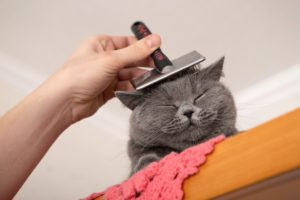Most cat owners are familiar with the unsettling sound of their cat retching, often followed by the unpleasant sight of a hairball. While hairballs are a common occurrence in cats, understanding why they happen and how to prevent them can significantly improve your cat’s comfort and your peace of mind.
Cats vomit hairballs as a natural consequence of their meticulous grooming habits. As they groom, they ingest loose fur, which can accumulate in their stomach. While some hair passes through their digestive system, excess hair can form hairballs that they expel through vomiting. Fortunately, there are effective strategies to minimize and prevent hairballs. Regular grooming, dietary adjustments including fiber supplementation, and specialized hairball control cat foods are all helpful approaches. This article will delve into the reasons behind Cat Hairball Vomit and provide comprehensive guidance on prevention.
Why Do Cats Experience Hairball Vomit?
The primary reason cats develop hairballs, leading to hairball vomit, is their inherent grooming behavior. Cats are fastidious groomers, spending a significant portion of their day cleaning their fur. Their tongues are covered in tiny, backward-facing barbs called papillae, which act like a natural comb, effectively removing loose hair and debris. During grooming, loose hair adheres to these papillae and is subsequently swallowed.
In most cases, the ingested hair passes smoothly through the digestive tract and is eliminated in the stool. However, when a considerable amount of hair is swallowed, or when the digestive system struggles to process it efficiently, hairballs can form in the stomach. These hairballs are essentially masses of undigested fur. When the accumulation becomes too large or irritating, the cat’s natural reflex is to expel it through vomiting – resulting in what we know as cat hairball vomit.
The expelled hairball often appears tube-shaped and moist, typically ranging in size from about a quarter to half an inch in diameter and one to two inches in length. Visually, it’s often compared to the size and shape of a small tootsie roll. Long-haired cat breeds, such as Maine Coons and Ragdolls, are generally more prone to hairballs due to their greater volume of fur. As cats mature, their grooming efficiency increases, often leading to a higher incidence of hairballs compared to when they were kittens.
Common Causes Contributing to Cat Hairball Vomit
While grooming is the fundamental cause, several factors can contribute to the frequency and severity of cat hairball vomit:
Diligent Grooming Habits
A cat’s commitment to cleanliness is a major factor in hairball formation. Long-haired breeds naturally ingest more hair during grooming compared to their short-haired counterparts. Short-haired cats may process and excrete ingested hair more easily through their feces. Cats who are stressed or anxious may also over-groom, increasing the likelihood of hairball development and subsequent cat hairball vomit.
Hunting and Ingesting Prey
Although domestic cats are often fed commercial cat food, their predatory instincts remain. When cats hunt and consume prey like rodents or birds, they may ingest fur along with the animal. Larger prey, such as rabbits or squirrels, can have significant amounts of fur. Cats may lick and bite at the fur of their prey before consuming it, leading to the ingestion of hair that can contribute to hairball formation and cat hairball vomit.
Licking Surfaces and Territory Marking
Cats sometimes exhibit unusual behaviors, such as licking carpets or other surfaces. This behavior can be related to territory marking, where cats deposit scent through saliva. Carpets and similar surfaces often harbor loose fibers and pet hair. Ingesting these fibers along with accumulated hair can contribute to the formation of hairballs and trigger cat hairball vomit.
Ingestion of Toys and Foreign Materials
Playful cats, particularly kittens and younger cats, may chew or ingest parts of their toys. Toys with strings, ribbons, or fibrous materials pose a risk. If ingested, these materials can not only contribute to hairball formation but also create dangerous intestinal blockages. Ingesting toy parts is a serious concern and can necessitate immediate veterinary attention, especially if it leads to a blockage in addition to cat hairball vomit.
Effective Strategies to Prevent Cat Hairball Vomit
Fortunately, there are several proactive measures you can take to minimize or prevent cat hairball vomit and help your feline companion.
Regular and Frequent Brushing
Consistent brushing is a cornerstone of hairball prevention. Brushing removes loose fur from your cat’s coat before it can be ingested during grooming. Aim to brush your cat at least two to three times a week, and more frequently for long-haired breeds, potentially daily during shedding seasons. Utilize brushes designed for cats, such as slicker brushes or grooming combs, to effectively remove loose undercoat and surface hair. Regular brushing also provides an excellent opportunity for bonding with your cat.
Baby Wipes or Damp Cloths for Loose Fur Removal
After brushing, or as a quick grooming aid between brushing sessions, unscented, hypoallergenic baby wipes or a damp cloth can be used to wipe down your cat’s coat. This helps to pick up any remaining loose fur that brushing might have missed. Many cats enjoy the sensation of being wiped down with a cool, damp cloth. This method is particularly helpful for cats who shed heavily.
Fiber-Rich Diet
Incorporating fiber into your cat’s diet can significantly aid in digestive health and hairball management. Fiber helps to add bulk to the stool and promotes the movement of hair through the digestive tract, reducing the likelihood of hairball formation and cat hairball vomit. Good sources of fiber that can be safely added to a cat’s diet in moderation include:
- Wheat bran
- Cooked oatmeal
- Pureed pumpkin (unsweetened)
- Cooked carrots
- Green beans
- Broccoli
Always consult with your veterinarian before introducing new foods or fiber supplements to your cat’s diet to ensure appropriate types and quantities are used.
Specialized Hairball Control Cat Food
Many reputable cat food brands offer formulations specifically designed to minimize hairballs. These hairball control cat foods typically contain higher levels of fiber, along with increased moisture, omega fatty acids, and sometimes digestive enzymes. These ingredients work synergistically to promote healthy digestion and facilitate the passage of hair through the digestive system, reducing the incidence of cat hairball vomit. Consider transitioning your cat to a hairball control formula, particularly if hairballs are a frequent problem.
Lubricating the Digestive Tract
Gentle lubrication of the digestive tract can assist in the smooth passage of hair. Small amounts of certain oils can be beneficial. Options include:
- Fish oil: A small amount of fish oil, rich in omega-3 fatty acids, can help lubricate the digestive tract and also promote healthy skin and coat.
- Olive oil or melted butter: A teaspoon of olive oil or melted unsalted butter added to food occasionally can also provide lubrication.
- Canned tuna in oil: Small servings of canned tuna packed in oil (drained before serving in moderation) can be palatable to cats and provide omega-3s and lubrication.
Use these oils sparingly and not as a daily supplement, as excessive fat intake can lead to digestive upset.
Ensure Adequate Water Intake
Proper hydration is crucial for overall health and digestive function. Ensuring your cat drinks enough water can help keep stools soft and promote regular bowel movements, aiding in the elimination of hair. Encourage water intake by:
- Providing fresh, clean water at all times in multiple locations.
- Using a cat water fountain, as many cats prefer moving water.
- Offering canned wet food, which has a higher moisture content than dry kibble.
Adequate hydration supports overall digestive health and can help minimize cat hairball vomit.
When is Cat Hairball Vomit a Cause for Concern?
While occasional hairball vomit is usually normal for cats, frequent or excessive vomiting, or vomiting accompanied by other symptoms, can indicate a more serious issue. In rare cases, a hairball can become lodged in the digestive tract, causing a blockage known as an intestinal obstruction. This is a serious, potentially life-threatening condition that may require surgery.
Seek immediate veterinary attention if your cat exhibits any of the following signs in conjunction with or independent of hairball vomit:
- Loss of appetite or refusal to eat
- Lethargy or decreased energy levels
- Persistent or excessive coughing
- Frequent vomiting, especially if unproductive or not producing hairballs
- Constipation or straining to defecate
- Diarrhea
These symptoms can indicate a hairball obstruction or other underlying medical conditions requiring prompt veterinary diagnosis and treatment.
 A woman is brushing a tabby cat
A woman is brushing a tabby cat
In Conclusion
Cat hairball vomit is a common consequence of feline grooming habits, but it doesn’t have to be a frequent or distressing event. By understanding the causes and implementing preventative strategies such as regular grooming, dietary adjustments, and ensuring adequate hydration, you can significantly reduce the occurrence of hairballs and improve your cat’s well-being. Be vigilant for signs that may indicate a more serious problem and always consult your veterinarian if you have concerns about your cat’s health or the frequency of their hairball vomit.

